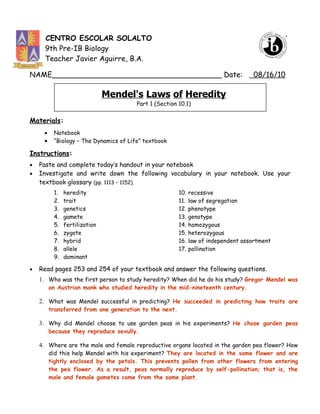
Mendel's laws of heredity part 1 (pp.253-254) - answer key
- 1. CENTRO ESCOLAR SOLALTO 9th Pre-IB Biology Teacher Javier Aguirre, B.A. NAME_____________________________________ Date: 08/16/10 Mendel's Laws of Heredity Part 1 (Section 10.1) Materials: • Notebook • “Biology – The Dynamics of Life” textbook Instructions: • Paste and complete today’s handout in your notebook • Investigate and write down the following vocabulary in your notebook. Use your textbook glossary (pp. 1113 – 1152). 1. heredity 10. recessive 2. trait 11. law of segregation 3. genetics 12. phenotype 4. gamete 13. genotype 5. fertilization 14. homozygous 6. zygote 15. heterozygous 7. hybrid 16. law of independent assortment 8. allele 17. pollination 9. dominant • Read pages 253 and 254 of your textbook and answer the following questions. 1. Who was the first person to study heredity? When did he do his study? Gregor Mendel was an Austrian monk who studied heredity in the mid-nineteenth century. 2. What was Mendel successful in predicting? He succeeded in predicting how traits are transferred from one generation to the next. 3. Why did Mendel choose to use garden peas in his experiments? He chose garden peas because they reproduce sexully. 4. Where are the male and female reproductive organs located in the garden pea flower? How did this help Mendel with his experiment? They are located in the same flower and are tightly enclosed by the petals. This prevents pollen from other flowers from entering the pea flower. As a result, peas normally reproduce by self-pollination; that is, the male and female gametes come from the same plant.
- 2. 5. What did Mendel do when he wanted to breed, or cross, one plant with another? What is the name of this process? Why did Mendel use this technique? Mendel opened the petals of a flower and removed the male organs. He then dusted the female organ with pollen from the plant he wished to cross it with. This process is called cross-fertilization. By using this technique, Mendel could be sure of the parents in his cross. 6. Mendel was seen as a careful researcher. Please explain what he did to carefully control his experiments with peas. He studied only one trait at a time to control variables, and he analyzed his data mathematically. The tall pea plants he worked with were from populations of plants that had been tall for many generations and had always produced tall offspring. Such plants are said to be true breeding for tallness. Likewise, the short plants he worked with were ture breeding for shortness. • Homework: 1. Please reproduce Figure 10.1 in your notebook. 2. Study today’s vocabulary for tomorrow’s short quiz.
